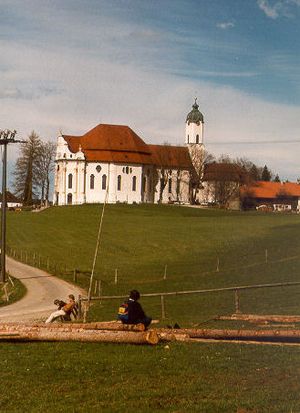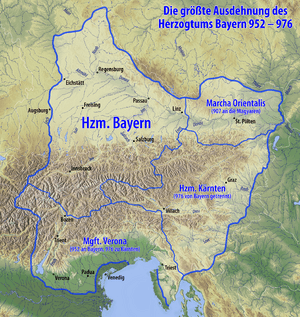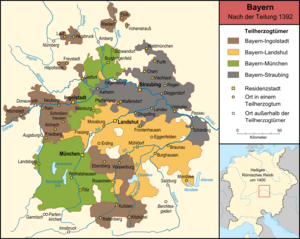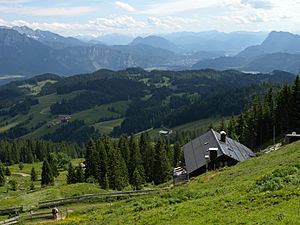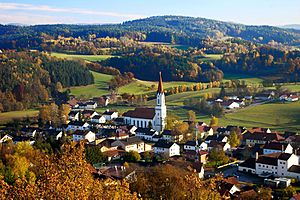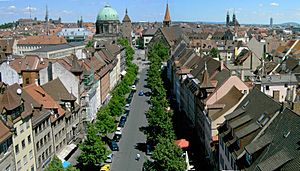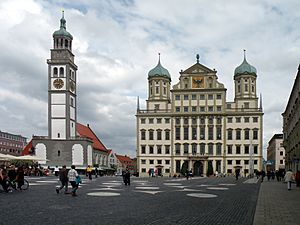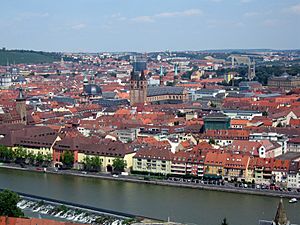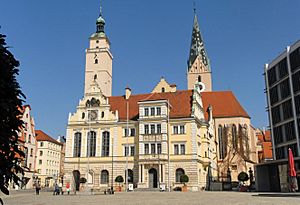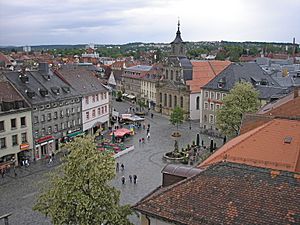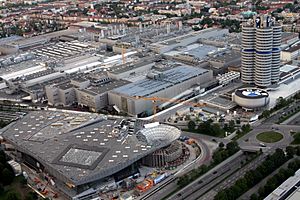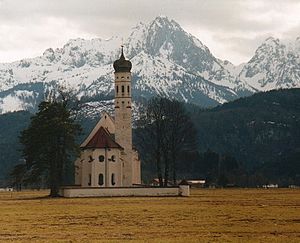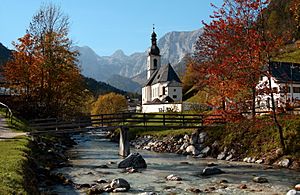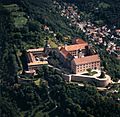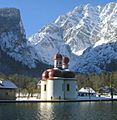Bavaria facts for kids
Quick facts for kids
Bavaria
Freistaat Bayern
|
|||
|---|---|---|---|
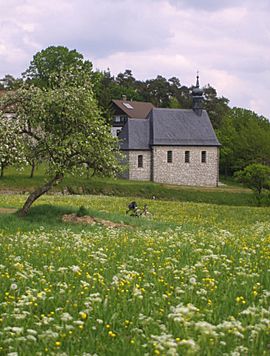
Village church in Franconia
|
|||
|
|||
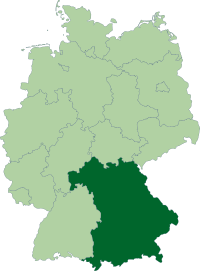
Position of Bavaria in Germany
|
|||
| Country | Germany | ||
| Capital | Munich | ||
| Area | |||
| • City | 70,549 km2 (27,239 sq mi) | ||
| Population
(11/2006)
|
|||
| • City | 12,495,000 | ||
| • Density | 177.111/km2 (458.715/sq mi) | ||
| Time zone | UTC+1 (CET) | ||
| • Summer (DST) | UTC+2 (CEST) | ||
| Website | bayern.de | ||
Bavaria (called Bayern in German) is the largest state in Germany. Its capital city is Munich, where about 1.3 million people live. Overall, about 12.5 million people call Bavaria home. Like many German states, Bavaria used to be an independent country. Ludwig II of Bavaria was its last king before it joined Germany.
Contents
History of Bavaria
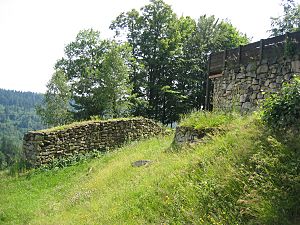
Early History: How Bavarians Formed
The people of Bavaria first appeared north of the Alps. This area was once home to the Celts and later part of the Roman Empire. The Bavarians spoke Old High German. Unlike other groups, they probably didn't move here from somewhere else. Instead, they seem to have formed from different groups left behind when the Romans left in the late 400s. These groups included Celts, Romans, and other Germanic tribes. The name "Bavarian" means "Men of Baia," which might refer to Bohemia. This was the homeland of the Celtic Boii people.
Middle Ages: Dukes and Kings
From about 554 to 788, the Agilolfing family ruled Bavaria as a duchy. This ended when Charlemagne removed Duke Tassilo III. Early dukes like Garibald I and Tassilo I of Bavaria helped shape the region. Theodo of Bavaria invited church leaders to strengthen Christianity around 696.
Saint Boniface helped convert the people to Christianity in the early 700s. Bavaria was also greatly affected by the Protestant Reformation in the 1500s.
Duke Tassilo III of Bavaria became ruler at age eight. He tried to rule independently but was eventually removed by his cousin Charlemagne in 788. This ended the Agilolfing family's rule.
For the next 400 years, many families ruled Bavaria. In 976, Bavaria lost large areas in the south and southeast. This led to the founding of Austria.
One of the most important dukes was Henry the Lion. He founded Munich and was very powerful. In 1180, Bavaria was given to the House of Wittelsbach family. They ruled for a very long time, from 1180 to 1918. The Wittelsbachs also gained control of the Electorate of the Palatinate in 1214.
Bavaria was divided several times, starting in 1255. By 1506, most parts of Bavaria were reunited. Munich became the only capital.
Electorate of Bavaria: A Powerful State
In 1623, during the Thirty Years' War, the Bavarian duke gained a powerful position. This made Bavaria one of the most important states in the Holy Roman Empire. It also became a center for the Counter-Reformation, supported by the Jesuits.
In the 1700s, Bavaria fought several wars with Austria. From 1777, Bavaria and the Palatinate were ruled together by the same family.
Kingdom of Bavaria: Napoleon's Influence
When Napoleon ended the Holy Roman Empire, Bavaria became a kingdom in 1806. Its size doubled. Some areas like Tyrol and Salzburg were briefly part of Bavaria but later given to Austria. In return, Bavaria gained the Palatinate and Franconia regions in 1815.
Between 1799 and 1817, a leading minister named Count Maximilian Joseph von Montgelas modernized Bavaria. He created new government structures that are still important today. In 1808, Bavaria got its first constitution. A new version in 1818 set up a parliament with two houses. This constitution lasted until the end of World War I.
Joining the German Empire
After Prussia became powerful, Bavaria kept its independence by balancing Prussia and Austria. Bavaria fought with Austria in the 1866 Austro-Prussian War and lost. It did not join the North German Confederation.
However, when France declared war on Prussia in 1870, Bavaria and other southern German states joined Prussia. They then became part of the new German Empire in 1871. Bavaria remained a monarchy and had special rights within the empire. It even had its own army, railways, and postal service.
Free State of Bavaria: After the Monarchy
After World War I, the monarchy ended in Germany. Bavaria became a "Free State." On November 12, 1918, King Ludwig III of Bavaria signed a document releasing his officers from their oaths. The new government saw this as him giving up the throne. No member of the Wittelsbach family has officially given up their claim to the throne since then. However, they also haven't tried to reclaim it.
Bavarian Identity
Bavarians often feel a strong separate identity. They see themselves as "Bavarians" first and "Germans" second. This feeling grew when the Kingdom of Bavaria joined the mostly Protestant German Empire. Many Catholic Bavarians did not like being ruled by the Protestant northerners from Prussia.
Today, most Bavarians accept that Bavaria is part of Germany. However, they still celebrate their different cultural identities. These include Franconia in the north, Bavarian Swabia in the southwest, and Altbayern (Old Bavaria) in the east. Each region has its own dialect and traditions.
Coat of Arms
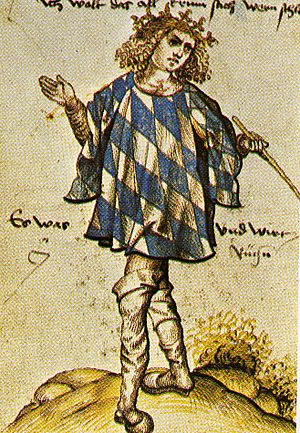
The modern coat of arms of Bavaria was designed in 1946. It follows old traditions.
- The Golden Lion: This lion represents the Upper Palatinate region.
- The "Franconian Rake": This striped design stands for Upper, Middle, and Lower Franconia.
- The Blue "Pantier": This mythical creature represents Lower and Upper Bavaria.
- The Three Lions: These lions represent Swabia.
- The White-And-Blue Shield: This shield with white and blue diamond shapes is the main symbol of Bavaria. It represents Bavaria as a whole.
- The People's Crown: This crown sits on top of the coat of arms. It symbolizes the power of the people. It was added after the royal crown was removed in 1923.
Geography of Bavaria
Bavaria shares borders with Austria and the Czech Republic. It also borders Switzerland across Lake Constance. Since all these countries are part of the Schengen Area, the borders are open. Within Germany, Bavaria borders Baden-Württemberg, Hesse, Thuringia, and Saxony.
Two major rivers flow through Bavaria: the Danube (Donau) and the Main River. The Bavarian Alps form the border with Austria. Germany's highest peak, the Zugspitze, is in the Bavarian Alps. The Bavarian Forest and the Bohemian Forest are along the border with the Czech Republic.
The biggest cities in Bavaria are Munich, Nuremberg, Augsburg, Regensburg, Würzburg, Ingolstadt, Fürth, and Erlangen.
Administrative Divisions
Bavaria is divided into 7 administrative districts called Regierungsbezirke.
Administrative Districts (Regierungsbezirke)
- Altbayern:
* Upper Palatinate (German: Oberpfalz) * Upper Bavaria (Oberbayern) * Lower Bavaria (Niederbayern)
* Upper Franconia (Oberfranken) * Middle Franconia (Mittelfranken) * Lower Franconia (Unterfranken)
* Swabia (Schwaben)
Population and Area of Districts
| Administrative region | Capital | Population (2011) | Area (km2) | No. municipalities | |||
|---|---|---|---|---|---|---|---|
| Lower Bavaria | Landshut | 1,192,641 | 9.48% | 10,330 | 14.6% | 258 | 12.5% |
| Lower Franconia | Würzburg | 1,315,882 | 10.46% | 8,531 | 12.1% | 308 | 15.0% |
| Upper Franconia | Bayreuth | 1,067,988 | 8.49% | 7,231 | 10.2% | 214 | 10.4% |
| Middle Franconia | Ansbach | 1,717,670 | 13.65% | 7,245 | 10.3% | 210 | 10.2% |
| Upper Palatinate | Regensburg | 1,081,800 | 8.60% | 9,691 | 13.7% | 226 | 11.0% |
| Swabia | Augsburg | 1,788,729 | 14.21% | 9,992 | 14.2% | 340 | 16.5% |
| Upper Bavaria | Munich | 4,418,828 | 35.12% | 17,530 | 24.8% | 500 | 24.3% |
| Total | 12,583,538 | 100.0% | 70,549 | 100.0% | 2,056 | 100.0% | |
Local Districts (Bezirke)
Bezirke are another type of local government in Bavaria. They have their own parliaments and handle local issues. These are different from the Regierungsbezirke, which are mainly for state administration.
Rural and Urban Districts
Bavaria has 71 rural districts (called Landkreise) and 25 independent cities (kreisfreie Städte). These independent cities act like their own districts.
Rural Districts (Landkreise)
Independent Cities (Kreisfreie Städte)
Municipalities (Gemeinden)
The rural districts are further divided into 2031 regular municipalities (Gemeinden). When you add the 25 independent cities, Bavaria has a total of 2056 municipalities.
Some areas are "unincorporated," meaning they don't belong to any municipality. These are usually uninhabited forests or lakes.
Major Cities in Bavaria
| City | Region | Inhabitants 31 December 2000 |
Inhabitants 31 December 2005 |
Inhabitants 31 December 2010 |
Inhabitants 31 December 2015 |
Changes 2000 – 2010 in % |
|---|---|---|---|---|---|---|
| Munich | Upper Bavaria | 1,210,223 | 1,259,677 | 1,353,186 | 1,450,381 | +11.81 |
| Nuremberg | Middle Franconia | 488,400 | 499,237 | 505,664 | 509,975 | +3.53 |
| Augsburg | Swabia | 254,982 | 262,676 | 264,708 | 286,374 | +3.81 |
| Regensburg | Upper Palatinate | 125,676 | 129,859 | 135,520 | 145,465 | +7.83 |
| Ingolstadt | Upper Bavaria | 115,722 | 121,314 | 125,088 | 132,438 | +8.09 |
| Würzburg | Lower Franconia | 127,966 | 133,906 | 133,799 | 124,873 | +4.56 |
| Fürth | Middle Franconia | 110,477 | 113,422 | 114,628 | 124,171 | +3.76 |
| Erlangen | Middle Franconia | 100,778 | 103,197 | 105,629 | 108,336 | +4.81 |
| Bayreuth | Upper Franconia | 74,153 | 73,997 | 72,683 | 72,148 | −1.98 |
| Bamberg | Upper Franconia | 69,036 | 70,081 | 70,004 | 73,331 | +1.40 |
| Aschaffenburg | Lower Franconia | 67,592 | 68,642 | 68,678 | 68,986 | +1.61 |
| Landshut | Lower Bavaria | 58,746 | 61,368 | 63,258 | 69,211 | +7.68 |
| Kempten (Allgäu) | Swabia | 61,389 | 61,360 | 62,060 | 66,947 | +1.09 |
| Rosenheim | Upper Bavaria | 58,908 | 60,226 | 61,299 | 61,844 | +4.06 |
| Neu-Ulm | Swabia | 50,188 | 51,410 | 53,504 | 57,237 | +6.61 |
| Schweinfurt | Lower Franconia | 54,325 | 54,273 | 53,415 | 51,969 | −1.68 |
| Passau | Lower Bavaria | 50,536 | 50,651 | 50,594 | 50,566 | +0.11 |
| Freising | Upper Bavaria | 40,890 | 42,854 | 45,223 | 46,963 | +10.60 |
| Straubing | Lower Bavaria | 44,014 | 44,633 | 44,450 | 46,806 | +0.99 |
| Dachau | Upper Bavaria | 38,398 | 39,922 | 42,954 | 46,705 | +11.87 |
Government and Politics
How Bavaria is Governed
Bavaria has its own constitution, which was created in 1946 after World War II. This constitution guides how the state is run.
Bavaria has a single parliament called the Landtag. Its members are chosen by the people in elections. Until 1999, there was also a Senat (Senate), but this was removed after a public vote.
The Bavarian State Government is led by the Minister-President of Bavaria. This person is elected by the parliament for five years and is the head of the state. The Minister-President chooses 11 ministers and 6 secretaries to help run the government.
Why "Free State"?
Bavaria calls itself the "Free State of Bavaria" (Freistaat Bayern). Most other German states simply call themselves "State of X." The term "Free State" means it's a republic, not a monarchy, and it was adopted after the monarchy ended in Germany.
Economy
Bavaria has a very strong economy, one of the largest in Germany and Europe. In 2007, its total economic output (called GDP) was over 434 billion Euros. This means Bavaria's economy is larger than that of many countries. If Bavaria were its own country, it would rank among the top 10 economies in the world.
Many big companies have their main offices in Bavaria. These include car makers like BMW and Audi, and technology companies like Siemens. Other well-known companies are Munich Re, Allianz, Infineon, MAN, Wacker Chemie, Puma, Adidas, and Ruf.
Demographics
Bavaria's population was 12,843,514 in 2015. Many people from other countries live in Bavaria. The largest groups of immigrants are from:
| Rank | Nationality | Population estimate (2014) |
|---|---|---|
| 1 | 199,215 | |
| 2 | 118,208 | |
| 3 | 104,336 | |
| 4 | 96,656 | |
| 5 | 85,339 | |
| 6 | 76,815 | |
| 7 | 72,027 | |
| 8 | 64,818 | |
| 9 | 40,111 | |
| 10 | 40,111 |
Culture
| Religion in Bavaria - 2014 | ||||
|---|---|---|---|---|
| religion | percent | |||
| Catholics | 52% | |||
| EKD Protestants | 20% | |||
| Muslims | 4% | |||
| Other or none | 24% | |||
Bavarian culture is quite unique compared to the rest of Germany. You can see these differences, especially in smaller towns, less so in big cities.
Religion in Bavaria
Bavaria, especially the "Old Bavaria" region, has a long history of being Catholic. Even Pope Emeritus Benedict XVI was born in Marktl am Inn, Upper Bavaria. However, other parts of Bavaria, like Franconia and Swabia, have both Catholic and Protestant traditions.
In 2014, about 52% of Bavarians were Catholic. This number has been going down over the years. About 19.5% belonged to the Evangelical Lutheran Church. About 4% of the population were Muslims. The remaining 24% were either not religious or followed other faiths.
Bavarian Traditions
Bavarians are very proud of their traditions. You might see people wearing traditional clothes called Tracht on special days. For men, this means Lederhosen, and for women, it's a Dirndl. Old folk music is also very popular.
The Maibaum, or Maypole, is a traditional pole decorated with figures. In the Middle Ages, it showed what trades were in the village. This, along with bagpipes in the Upper Palatinate, shows the region's ancient Celtic and Germanic roots. There are also unique Bavarian sports, like Aperschnalzen, which is competitive whipcracking.
Bavarians living outside Germany also keep their traditions alive. For example, in New York, Bavarian groups hold festivals and dances. They also take part in the annual Steuben Parade.
Food and Drink
Bavarians love their food and drink. They have many famous dishes and some unique ones, like Weißwurst (white sausage). At festivals and in beer gardens, beer is often served in one-liter mugs (called a Maß).
Bavarians are very proud of their traditional Reinheitsgebot, or purity law for beer. This law, first made in 1487, says that beer can only have three ingredients: water, barley, and hops. This law became German law in 1906. Even though the European Union changed some rules, Bavarian breweries still follow it. Bavarians drink a lot of beer, about 170 liters per person each year, though this has decreased recently.
Bavaria is also home to the Franconian wine region. This area along the Main River has made wine for over 1,000 years. It's known for its special Bocksbeutel wine bottle. Wine production is a big part of the local culture, and many villages have their own wine festivals.
Language and Dialects
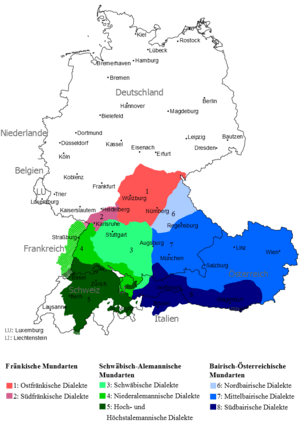
Mainly three German dialects are spoken in Bavaria. Austro-Bavarian is spoken in Old Bavaria (southeast and east). Swabian German is spoken in the Bavarian part of Swabia (southwest). East Franconian German is spoken in Franconia (north). In the small town of Ludwigsstadt, a Thuringian dialect is spoken. In the 1900s, more people started speaking Standard German, especially in the cities.
Sports

Football
Bavaria has many football clubs. These include FC Bayern Munich, 1. FC Nuremberg, FC Augsburg, TSV 1860 München, FC Ingolstadt 04, and SpVgg Greuther Fürth.
FC Bayern Munich is the most popular and successful football team in Germany. They have won a record 27 German titles. 1. FC Nuremberg is next with 9 titles. SpVgg Greuther Fürth has won 3 championships, and TSV 1860 München has won once. FC Bayern also won the 2013 UEFA Champions League final.
Historical Buildings
-
Veste Coburg in Coburg
-
Festspielhaus of Richard Wagner in Bayreuth
-
Imperial Castle in Nuremberg
-
Kastell Biriciana, Weissenburg close to the Limes
-
Kreuztor in Ingolstadt
-
Old Stone Bridge and Cathedral of Regensburg
Images for kids
-
Expression of Bavarian (linguistic) identity in a shop window in the town of Regensburg, Upper Palatinate
-
Munich city center with Frauenkirche (left) and Rathaus (town hall)
-
Regensburg with the Danube (foreground) and Regensburg Cathedral
-
A Catholic church near Füssen with the Alps in the background
-
Upper German and the southern counterpart to Central German both form the High German languages, while the Austro-Bavarian dialects are in blue
See also
 In Spanish: Baviera para niños
In Spanish: Baviera para niños



